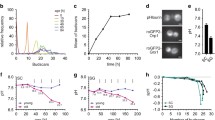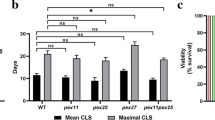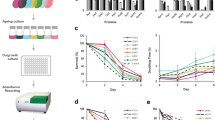Abstract
One of the mechanistic approaches for explaining ageing is the oxidative stress theory of ageing. Saccharomyces cerevisiae has been used as a model to study ageing due to many factors. We have attempted to investigate if the differential ability to withstand oxidative stress can be correlated with their lifespans. In all the four strains studied (AP22, 699, 8C, and SP4), there was no age-associated increases in lipid peroxidation levels measured as thiobarbituric acid reactive substances (TBARS). Under induced oxidative stress conditions, there was an increased TBARS level in both the ages assessed with a quantum-fold increase in the stationary phase cells of AP22. In contrast, the late stationary phase cells of 8C exhibited the least susceptibility to induced oxidative stress. The level of TBARS in both exponential and late stationary phase cells of 699 was overall more than that in the other three strains. Protein carbonylation increased with age in 8C and 699. Induced stress increased carbonylation in the exponential cells of SP4 and 699 and the stationary phase cells of all four strains. Protein carbonylation data indicate that the AP22 cells exhibit decreased protein carbonylation vis-à-vis the other strains. Induced stress data showed that while the exponential cells of 699 are susceptible, the late stationary phase cells of 699 are most resistant. Western blotting analysis using anti-HNE antibodies showed two proteins of molecular mass ~ 56 and ~ 84 kDa that were selectively modified with age in all the strains. Under induced stress conditions, an additional protein of ~ 69 kDa was oxidized. Our investigation shows that the difference in lifespan between the four strains of S. cerevisiae may be regulated by oxidative stress. Knowledge of the identity of the oxidized proteins will significantly facilitate a better understanding of the effect of oxidative stress conditions on the cells of S. cerevisiae.




Similar content being viewed by others
Data Availability
Will be made available on reasonable request to the first author.
References
Agarwal S, Sohal RS (1993) Relationship between aging and susceptibility to protein oxidative damage. Biochem Biophys Res Commun 194:1203–1206
Amici A, Levine RL, Tsai L, Stadtman ER (1989) Conversion of amino acid residues in proteins and amino acid homopolymers to carbonyl derivatives by metal-catalyzed oxidation reactions. J Biol Chem 264:3341–3346
Arlia-Ciommo A, Leonov A, Beach A, Richard VR, Bourque SD, Burstein MT, Kyryakov P, Gomez-Perez A, Koupaki O, Feldman R, Titorenko VI (2018) Caloric restriction delays yeast chronological aging by remodelling carbohydrate and lipid metabolism, altering peroxisomal and mitochondrial functionalities, and postponing the onsets of apoptotic and liponecrotic modes of regulated cell death. Oncotarget 9:16163–16184
Arslan M, Holyavkin C, Kısakesen H, Topaloğlu A, Sürmeli Y, Çakar ZP (2018) Physiological and transcriptomic analysis of a chronologically long-lived Saccharomyces cerevisiae strain obtained by Evolutionary Engineering. Mol Biotechnol 60:468–484
Balaban BG, Yılmaz Ü, Alkım C, Topaloğlu A, Kısakesen H, Holyavkin C, Çakar ZP (2020) Evolutionary Engineering of an Iron-resistant Saccharomyces cerevisiae Mutant and its physiological and molecular characterization. Microorganisms 8:43
Banerjee R, Joshi N, Nagotu S (2020) Cell organelles and yeast longevity: an intertwined regulation. Curr Genet 66:15–41
Botstein D, Chervitz SA, Cherry JM (1997) Yeast as a model organism. Science 277:1259–1260
Cabiscol E, Piulats E, Echave P, Herrero E, Ros J (2000) Oxidative stress promotes specific protein damage in Saccharomyces cerevisiae. J Biol Chem 275:27393–27398
Chen Q, Ding Q, Keller JN (2005) The stationary phase model of aging in yeast for the study of oxidative stress and age-related neurodegeneration. Biogerontology 6:1–13
Collinson LP (1992) Inducibility of the response of yeast cells to peroxide stress. J Gen Microbiol 138:329–335Dawes IW ()
Costa V, Moradas-Ferreira P (2001) Oxidative stress and signal transduction in Saccharomyces cerevisiae: insights into ageing, apoptosis and diseases. Mol Aspects Med 22:217–246
Das N, Jana CK (2015) Age-associated oxidative modifications of mitochondrial α subunit of F1 ATP synthase from mouse skeletal muscles. Free Radic Res 49:954–961
Das N, Levine RL, Orr WC, Sohal RS (2001) Selectivity of protein oxidative damage during aging in Drosophila melanogaster. Biochem J 360:209–216
Deb R, Nagotu S (2022) The nexus between peroxisome abundance and chronological ageing in Saccharomyces cerevisiae. https://doi.org/10.1007/s10522-022-09992-9. Biogerontology
Deori NM, Kale A, Maurya PK, Nagotu S (2018) Peroxisomes: role in cellular ageing and age related disorders. Biogerontology 19:303–324
Esterbauer H, Schaur RJ, Zollner H (1991) Chemistry and biochemistry of 4-hydroxynonenol, malondialdehyde and related aldehydes. Free Radic Biol Med 11:81–128
Gokulrangan G, Zaidi A, Michaelis ML, Schöneich C (2007) Proteomic analysis of protein nitration in rat cerebellum: effect of biological aging. J Neurochem 100:1494–1504
Halliwell B, Gutteridge J (2007) Free Radicals in Biology and Medicine, 4th edn. Oxford University Press, New York
Harman D (1956) Aging, a theory based on free radicals and radiation chemistry. J Gerontol A Biol Sci Med Sci 2:298–300
Harman D (1972) Free-radical theory of aging—dietary implications. Am J Clin Nutr 25:839–843
Hussain SNA, Matar G, Barreiro E, Florian M, Divangahi M, Vassilakopoulos T (2006) Modifications of proteins by 4-hydroxy-2-nonenal in the ventilator muscles of rats. Am J Physiol Lung Cell Mol Physiol 290::L996–1003
Imai SI, Guarente L (2016) It takes two to tango: NAD+ and Sirtuins in aging/longevity control. NPJ Aging Mech Dis 2:16017
Jana CK, Das N, Sohal RS (2002) Specificity of age-related carbonylation of plasma proteins in the mouse and rat. Arch Biochem Biophys 397:433–439
Kanski J, Alterman MA, Schöneich C (2003) Proteomic identification of age-dependent protein nitration in rat skeletal muscle. Free Radic Biol Med 35:1229–1239
Kanski J, Behring A, Pelling J, Schöneich C (2005) Proteomic identification of 3-nitrotyrosine-containing rat cardiac proteins: effects of biological aging. Am J Physiol Heart Circ Physiol 288:H371–H381
Kocaefe-Özşen N, Yilmaz B, Alkım C, Arslan M, Topaloğlu A, Kısakesen Ḣ, Gülsev E, Çakar ZP (2022) Physiological and molecular characterization of an oxidative stress-resistant Saccharomyces cerevisiae strain obtained by Evolutionary Engineering. Front Microbiol 13:822864
Laemmli UK (1970) Cleavage of structural proteins during assembly of the head of bacteriophage T4. Nature 227:680–685
Lautrup S, Sinclair DA, Mattson MP, Fang EF (2019) NAD+ in brain aging and neurodegenerative disorders. Cell Metab 30:630–655
Levine RL, Garland D, Oliver CN, Amici A, Climent I, Lenz AG, Ahn BW, Shaltiel S, Stadtman ER (1990) Determination of carbonyl content in oxidatively modified proteins. Methods Enzymol 186:464–478
Longo VD, Ellerby LM, Bredesen DE, Valentine JS, Gralla EB (1997) Human Bcl-2 reverses survival defects in yeast lacking superoxide dismutase and delays death of wild-type yeast. J Cell Biol 137:1581–1588
Lowry OH, Rosebrough NJ, Farr AL, Randall RJ (1951) Protein measurement with the Folin phenol reagent. J Biol Chem 193:265–275
Lushchak V, Gospodaryov D (2005) Catalases protect cellular proteins from oxidative modification in Saccharomyces cerevisiae. Cell Biol Intern 29:187–192
Mejía-Barajas JA, Montoya-Pérez R, Salgado-Garciglia R, Aguilera-Aguirre L, Cortés-Rojo C, Mejía-Zepeda R, Arellano-Plaza M, Saavedra-Molina A (2017) Oxidative stress and antioxidant response in a thermotolerant yeast. Brazilian J Microbiol 48:326–332
Mukherjee M, Nandi A, Chandra K, Saikia SK, Jana CK, Das N (2020) Protein extraction from Saccharomyces cerevisiae at different growth phases. J Microbiol Methods 172:105906
Odoh CK, Guo X, Arnone JT, Wang X, Zhao ZK (2022) The role of NAD and NAD precursors on longevity and lifespan modulation in the budding yeast, Saccharomyces cerevisiae. Biogerontology 23:169–199
Ohkawa H, Ohishi N, Yagi K (1979) Assay for lipid peroxides in animal tissues by thiobarbituric acid reaction. Anal Biochem 95:351–358
Parry JM, Davies PJ, Evans WE (1976) The effects of “cell age” upon the lethal effects of physical and chemical mutagens in the yeast, Saccharomyces cerevisiae. Molec Gen Genetics 146:27–35
Poon HF, Vaishnav RA, Getchell TV, Getchell ML, Butterfield DA (2006) Quantitative proteomics analysis of differential protein expression and oxidative modification of specific proteins in the brains of old mice. Neurobiol Aging 27:1010–1019
Purdel NC, Margina D, Ilie M (2014) Current methods used in the protein carbonyl assay. Ann Res & Rev Biol 4:2015–2026
Rajman L, Chwalek K, Sinclair DA (2018) Therapeutic potential of NAD-boosting molecules: the in vivo evidence. Cell Metab 27:529–547
Reverter-Branchat G, Cabiscol E, Tamarit J, Ros J (2004) Oxidative damage to specific proteins in replicative and chronological-aged Saccharomyces cerevisiae: common targets and prevention by calorie restriction. J Biol Chem 279:31983–31989
Sampaio-Marques B, Burhans WC, Ludovico P (2019) Yeast at the Forefront of research on ageing and age-related diseases. In: Sá-Correia I (Ed) Yeasts in biotechnology and human health. Progress in Molecular and Subcellular Biology, vol 58. Springer, pp 217–242
Schenberg-Frascino A, Moustacchi E (1972) Lethal and mutagenic effects of elevated temperature on haploid yeast. I. Variations in sensitivity during the cell cycle. Molec Gen Genetics 115:243–257
Shields HJ, Traa A, Van Raamsdonk JM (2021) Beneficial and detrimental effects of reactive oxygen species on lifespan: a comprehensive review of comparative and experimental studies. Front Cell Dev Biol 9:628157–628157
Sohal RS, Agarwal S, Sohal BH (1995) Oxidative stress and aging in the mongolian gerbil (Meriones unguiculatus). Mech Ageing Dev 81:15–25
Stadtman ER (1990) Metal ion-catalyzed oxidation of proteins: biochemical mechanism and biological consequences. Free Radic Biol Med 9:315–325
Stadtman ER (1992) Protein oxidation and aging. Science 257:1220–1224
Steels EL, Learmonth RP, Watson K (1994) Stress tolerance and membrane lipid unsaturation in Saccharomyces cerevisiae grown aerobically or anaerobically. Microbiol (Reading) 140:569–576
Stojkovski V, Hadzi-Petrushev N, Ilieski V, Sopi R, Gjorgoski I, Mitrov D, Jankulovski N, Mladenov M (2013) Age and heat exposure-dependent changes in antioxidant enzymes activities in rat’s liver and brain mitochondria: role of α-tocopherol. Physiol Res 62:503–510
Tamarit J, de Hoogh A, Obis E, Alsina D, Cabiscol E, Ros J (2012) Analysis of oxidative stress-induced protein carbonylation using fluorescent hydrazides. J Proteom 75:3778–3788
Towbin H, Staehelin T, Gordon J (1979) Electrophoretic transfer of protein from polyacrylamide gels to nitrocellulose sheets: procedure and some applications. Proc Natl Acad Sci USA 76:4350–4354
Vaishnav RA, Getchell ML, Poon HF, Barnett KR, Hunter SA, Pierce WM, Klein JB, Butterfield DA, Getchel TV (2007) Oxidative stress in the aging murine olfactory bulb: redox proteomics and cellular localization. J Neurosci Res 85:373–385
Walton EF, Carter BLA, Pringle JR (1979) An enrichment method for temperature-sensitive and auxotrophic mutants of yeast. Molec Gen Genetics 171:111–114
Werner-Washburne M, Roy S, Davidson GS (2012) Aging and the survival of quiescent and non-quiescent cells in yeast stationary-phase cultures. Subcell Biochem 57:123–143
Winans MJ, Gallagher JEG (2020) Metallomic and lipidomic analysis of S. cerevisiae response to cellulosic copper nanoparticles uncovers drivers of toxicity. Metallomics 12:799–812
Yan LJ, Sohal RS (1998) Mitochondrial adenine nucleotide translocase is modified oxidatively during aging. Proc Natl Acad Sci USA 95:12896–12901
Yan LJ, Levine RL, Sohal RS (1997) Oxidative damage during aging targets mitochondrial aconitase. Proc Natl Acad Sci USA 94:11168–11172
Yazawa H, Iwahashi H, Kamisaka Y, Kimura K, Uemura H (2009) Production of polyunsaturated fatty acids in yeast Saccharomyces cerevisiae and its relation to alkaline pH tolerance. Yeast 26:167–184
Acknowledgements
The authors thank Prof. T. Choudhuri, Department of Biotechnology, for the use of the Bio-Rad ChemiDoc™ XRS+ gel imaging system and Dr. Surjya Sakia, Department of Zoology, for help with the statistical analysis. The authors thank Dr. Kalpana Bhargava, DRDO, for the silver staining protocol. Assistance from Ms. Ankita Nandi for the preparation of the figures is also acknowledged.
Funding
This study was funded by grants from Science and Engineering Research Board/DST, India (SR/FT/LS-103/2008). MM thanks University Grants Commission, India for non-NET fellowship.
Author information
Authors and Affiliations
Contributions
MM performed the experiments, CKJ was involved in designing the experiments, data analysis and editing of the manuscript; ND was involved in designing the experiments, data analysis and writing and editing the manuscript.
Corresponding author
Ethics declarations
Conflict of interests
None.
Ethical approval
Not applicable.
Additional information
Publisher’s Note
Springer Nature remains neutral with regard to jurisdictional claims in published maps and institutional affiliations.
Electronic supplementary material
Below is the link to the electronic supplementary material.
Rights and permissions
Springer Nature or its licensor (e.g. a society or other partner) holds exclusive rights to this article under a publishing agreement with the author(s) or other rightsholder(s); author self-archiving of the accepted manuscript version of this article is solely governed by the terms of such publishing agreement and applicable law.
About this article
Cite this article
Mukherjee, M., Jana, C.K. & Das, N. Oxidation of biological molecules with age and induced oxidative stress in different growth phases of Saccharomyces cerevisiae. Antonie van Leeuwenhoek 116, 353–365 (2023). https://doi.org/10.1007/s10482-022-01807-8
Received:
Accepted:
Published:
Issue Date:
DOI: https://doi.org/10.1007/s10482-022-01807-8




